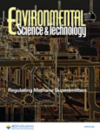 Metal contamination of rivers and streams generally occurs as a combination of multiple metals (so called mixtures). However, it is yet unresolved how risks of mixed metal contamination to ecosystems should be evaluated. We collated data from 30 different toxicity tests with metal mixtures and analysed them in a systematic way to derive general conclusions that can be used in risk assessment. We found cases in which different metals, each individually causing <10% toxicity (relative to uncontaminated water), caused much larger toxicity (up to 66%) when combined. This suggests that the current metal-by-metal approach in risk assessment may not be conservative enough for the environment. We also considered the use of two common mixture toxicity models to predict metal mixture toxicity.
Metal contamination of rivers and streams generally occurs as a combination of multiple metals (so called mixtures). However, it is yet unresolved how risks of mixed metal contamination to ecosystems should be evaluated. We collated data from 30 different toxicity tests with metal mixtures and analysed them in a systematic way to derive general conclusions that can be used in risk assessment. We found cases in which different metals, each individually causing <10% toxicity (relative to uncontaminated water), caused much larger toxicity (up to 66%) when combined. This suggests that the current metal-by-metal approach in risk assessment may not be conservative enough for the environment. We also considered the use of two common mixture toxicity models to predict metal mixture toxicity.News
 Metal contamination of rivers and streams generally occurs as a combination of multiple metals (so called mixtures). However, it is yet unresolved how risks of mixed metal contamination to ecosystems should be evaluated. We collated data from 30 different toxicity tests with metal mixtures and analysed them in a systematic way to derive general conclusions that can be used in risk assessment. We found cases in which different metals, each individually causing <10% toxicity (relative to uncontaminated water), caused much larger toxicity (up to 66%) when combined. This suggests that the current metal-by-metal approach in risk assessment may not be conservative enough for the environment. We also considered the use of two common mixture toxicity models to predict metal mixture toxicity.
Metal contamination of rivers and streams generally occurs as a combination of multiple metals (so called mixtures). However, it is yet unresolved how risks of mixed metal contamination to ecosystems should be evaluated. We collated data from 30 different toxicity tests with metal mixtures and analysed them in a systematic way to derive general conclusions that can be used in risk assessment. We found cases in which different metals, each individually causing <10% toxicity (relative to uncontaminated water), caused much larger toxicity (up to 66%) when combined. This suggests that the current metal-by-metal approach in risk assessment may not be conservative enough for the environment. We also considered the use of two common mixture toxicity models to predict metal mixture toxicity.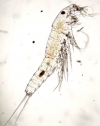 Copepods play a fundamental role in the food chain of our oceans as they feed on algae and get eaten by fish. Amongst others, the harpacticoid copepod species Nitocra spinipes has become a popular model species in aquatic toxicity testing over the past few decades. To understand the combined effects of chemical pollution and climate change-related stressors on copepod populations, a proper quantification of those processes is essential. In this study, GhEnToxLab researcher Josef Koch and his Swedish coauthors (Stockholm University) quantified the effects of temperature and food shortage as two climate change-related environmental stressors on Nitocra spinipes and implemented the corresponding stress functions into an individual-based population model for this species.
Copepods play a fundamental role in the food chain of our oceans as they feed on algae and get eaten by fish. Amongst others, the harpacticoid copepod species Nitocra spinipes has become a popular model species in aquatic toxicity testing over the past few decades. To understand the combined effects of chemical pollution and climate change-related stressors on copepod populations, a proper quantification of those processes is essential. In this study, GhEnToxLab researcher Josef Koch and his Swedish coauthors (Stockholm University) quantified the effects of temperature and food shortage as two climate change-related environmental stressors on Nitocra spinipes and implemented the corresponding stress functions into an individual-based population model for this species. Fleece clothing made its way to our wardrobe in the 90s. Since then wearing fleece has been appreciated to be easy, warm and comfortable. Fleece is however made out of polyethylene terephthalate (PET), the same material as plastic bottles. Despite its green image, since plastic bottles are sometimes recycled to fleece clothing, wearing fleece is not that eco-friendly as you would expect. The Standard and Knack interviewed Prof. Janssen to explain the issue of microplastic pollution originating from fleece clothing and its ecological consequences.
Fleece clothing made its way to our wardrobe in the 90s. Since then wearing fleece has been appreciated to be easy, warm and comfortable. Fleece is however made out of polyethylene terephthalate (PET), the same material as plastic bottles. Despite its green image, since plastic bottles are sometimes recycled to fleece clothing, wearing fleece is not that eco-friendly as you would expect. The Standard and Knack interviewed Prof. Janssen to explain the issue of microplastic pollution originating from fleece clothing and its ecological consequences.
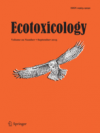 Darwin’s rules of “evolution” and “survival of the fittest” also apply to populations of organisms exposed to chemical substances. Our review of the scientific literature revealed that long-term exposure to two classes of persistent pollutants, PAH’s and PCB’s, can affect the evolutionary trajectory of natural populations and make them more resistant to these chemicals. In some cases, this has happened at pollutant levels below currently applicable environmental quality standards. This calls for integrating evolutionary processes into regulatory decision-making.
Darwin’s rules of “evolution” and “survival of the fittest” also apply to populations of organisms exposed to chemical substances. Our review of the scientific literature revealed that long-term exposure to two classes of persistent pollutants, PAH’s and PCB’s, can affect the evolutionary trajectory of natural populations and make them more resistant to these chemicals. In some cases, this has happened at pollutant levels below currently applicable environmental quality standards. This calls for integrating evolutionary processes into regulatory decision-making.
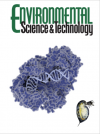 Over the last decade, it has become clear that epigenetic mechanisms could play a role in the toxicity of environmental toxicants. Epigenetic mechanisms are mechanisms that alter the DNA strands without changing the DNA itself.In this study, we focus on the DNA methylation patterns in the waterflea exposed to a toxic blue green algae. We studied the methylation patterns in exposed and unexposed animals and found significant differences between the two treatments. Overall, this study suggests that DNA methylation plays an important role in the toxicity response.
Over the last decade, it has become clear that epigenetic mechanisms could play a role in the toxicity of environmental toxicants. Epigenetic mechanisms are mechanisms that alter the DNA strands without changing the DNA itself.In this study, we focus on the DNA methylation patterns in the waterflea exposed to a toxic blue green algae. We studied the methylation patterns in exposed and unexposed animals and found significant differences between the two treatments. Overall, this study suggests that DNA methylation plays an important role in the toxicity response.
 The British television and radio platform Sky has made a documentary – A plastic tide – on plastic pollution in the oceans. Our laboratory has a great expertise in microplastic pollution in the marine environment and performed the first comprehensive risk assessment on these tiny plastic fragments. In this picture, journalists of SkyNews visited our lab and talked to Prof. Janssen and Niels De Troyer to get the full story concerning the human exposure and effects of microplastics in seafood. In addition, the newspaper the Telegraph wrote an article about (micro)plastic pollution and refers to the conversation skynews had with Prof. Janssen.
The British television and radio platform Sky has made a documentary – A plastic tide – on plastic pollution in the oceans. Our laboratory has a great expertise in microplastic pollution in the marine environment and performed the first comprehensive risk assessment on these tiny plastic fragments. In this picture, journalists of SkyNews visited our lab and talked to Prof. Janssen and Niels De Troyer to get the full story concerning the human exposure and effects of microplastics in seafood. In addition, the newspaper the Telegraph wrote an article about (micro)plastic pollution and refers to the conversation skynews had with Prof. Janssen.
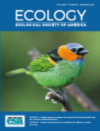 Biodiversity increases the stability of ecosystem functions in fluctuating environments. Only recently, parts of the underlying processes have been uncovered. A meta-analysis of biodiversity experiments manipulating primary producer richness revealed that the increased stability in more diverse systems was driven by an increased resistance (i.e. reduced changes), rather that an increased resilience (i.e. a rapid recovery). As many ecosystem functions, comprise the joint functional contribution of the species in the system, the stability of these ecosystem functions should depend on changes in the system’s composition. Theoretical models predict that an increased number of species interactions should slow down compositional changes. By consequence, biodiversity is expected to increase both compositional and functional resistance, but these predictions have never been put to the test. In this article, Baert et al. use marine diatom microcosms to demonstrate this tight link between compositional and functional stability.
Biodiversity increases the stability of ecosystem functions in fluctuating environments. Only recently, parts of the underlying processes have been uncovered. A meta-analysis of biodiversity experiments manipulating primary producer richness revealed that the increased stability in more diverse systems was driven by an increased resistance (i.e. reduced changes), rather that an increased resilience (i.e. a rapid recovery). As many ecosystem functions, comprise the joint functional contribution of the species in the system, the stability of these ecosystem functions should depend on changes in the system’s composition. Theoretical models predict that an increased number of species interactions should slow down compositional changes. By consequence, biodiversity is expected to increase both compositional and functional resistance, but these predictions have never been put to the test. In this article, Baert et al. use marine diatom microcosms to demonstrate this tight link between compositional and functional stability.
 On November 16th, the rector, vice-rector and dean officially opened the new building where our new lab facilities are located. The opening included a guided tour through our new lab facilities and offices in which we introduced visitors to our different research themes. We started with an introduction to ecotoxicology and the relevance of the dose-response curve, followed by a presentation on linking oceans and human health and concluded with our molecular research on genomic variation and environmental DNA. You can find some pictures of the opening below and at the ©beeldbank2016 UGent.
On November 16th, the rector, vice-rector and dean officially opened the new building where our new lab facilities are located. The opening included a guided tour through our new lab facilities and offices in which we introduced visitors to our different research themes. We started with an introduction to ecotoxicology and the relevance of the dose-response curve, followed by a presentation on linking oceans and human health and concluded with our molecular research on genomic variation and environmental DNA. You can find some pictures of the opening below and at the ©beeldbank2016 UGent.
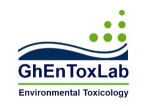 GhenToxLab is looking for an enthusiastic young scientist to join our research team as a full-time junior assistant. We are looking for a candidate with a background and interest in at least one of the following research domains: ecotoxicology, ecology, molecular biology and genomics. In addition, an interest in teaching as well as research is essential. As academic assisting staff you assist in teaching activities and perform academic research in preparation of your doctoral dissertation.
GhenToxLab is looking for an enthusiastic young scientist to join our research team as a full-time junior assistant. We are looking for a candidate with a background and interest in at least one of the following research domains: ecotoxicology, ecology, molecular biology and genomics. In addition, an interest in teaching as well as research is essential. As academic assisting staff you assist in teaching activities and perform academic research in preparation of your doctoral dissertation.
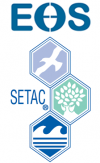 Past week, the first SETAC/iEOS joint Focused Topic Meeting on Environmental and (eco)toxicological omics and epigenetics was held in Ghent. Prof. Karel De Schamphelaere and Dr. Jana Asselman co-organized the meeting together with members from academia, government and industry. The four day meeting brought together 120 participants from across the globe. State of the art science, technology and regulatory perspectives were presented in 48 platform presentations and 34 posters. The meeting concluded with a challenging panel debate on how epigenetic effects can be addressed in regulatory frameworks and risk assessment.
Past week, the first SETAC/iEOS joint Focused Topic Meeting on Environmental and (eco)toxicological omics and epigenetics was held in Ghent. Prof. Karel De Schamphelaere and Dr. Jana Asselman co-organized the meeting together with members from academia, government and industry. The four day meeting brought together 120 participants from across the globe. State of the art science, technology and regulatory perspectives were presented in 48 platform presentations and 34 posters. The meeting concluded with a challenging panel debate on how epigenetic effects can be addressed in regulatory frameworks and risk assessment.
